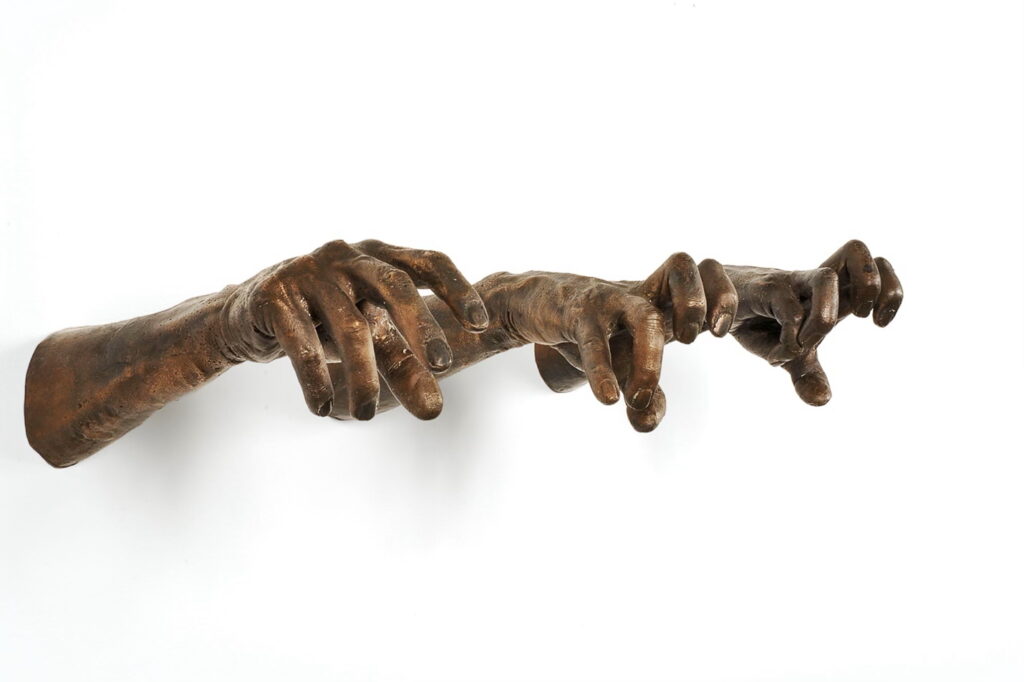- Yael Friedman
- Michael Murray
- Bob Bickford & Donnez Cardoza
- Camilla Taylor
- Susan Martin
- Michael Murray
- Yael Friedman
- Clare McCarthy
- Chris Robinson
- Craig Willms
- Elizabeth Tevlin
- Miguel Aragon
- Don Goldstein
- Craig Willms
- Kay Murcer
- Tony Martins
- Sophie Malleret
- Jordana Jacobs & Jake Cohen
- Yael Friedman
- Corwin Ericson
- Corwin Ericson
- Paul Ruta
How to throw a Knuckleball

Craig Willms Knuckleball:
bronze
each sculpture 10 x 15 x 35 cm
In a world of 100 mph fastballs and high spin sweepers, sliders, cutters, gyros and slurves, the knuckle ball floats across the plate slowly, almost spinless and erratic.
Former Major League catcher Bob Uecker famously stated, “the easiest way to catch a knuckleball was to wait until it stopped rolling and just pick it up.”
Contrary to its name, the knuckleball is not gripped with the knuckles, but with the fingernails and released off the fingertips with as little rotation as possible. The pitch’s unorthodox release and slow speed goes against the idea of power and precise location taught to pitchers from a young age. It is often learned as a last resort for pitchers who haven’t mastered other aspects of the game. It is thrown slowly, with little stress on the arm and simply propelled toward the catcher’s head allowing the erratic dance to deceive batters and sometimes even catchers themselves. It is such a unique pitch that there are rarely more than one or two pitchers carrying on the legacy of the knuckleball at any given time.
Tom Candiotti was the first I remember floating playoff knuckleballs that didn’t knuckle enough for my maybe-next-year Blue Jays of 1991. In 1992, when the Jays finally won the World Series, I found myself fascinated with Tim Wakefield’s debut season for the Pirates. Wakefield pitched on short rest for two victorious playoff games and was an oddity to me as I had come to think of knuckleballers as old guys learning the pitch as a last resort. The knuckleball was a last resort for him, but he had been a hitter who couldn’t hit rather than a pitcher who couldn’t pitch, and thus his transition to a big league knuckleballer happened as a young player. He would eventually become a legend for the rival Red Sox, who the Jays would play often in the AL East and a team I tried to watch with regularity when Pedro was traded from my beloved Expos. I would try to catch Red Sox games in the hope of catching an electrifying Pedro start or a fluttering slow dance of a Wakefield start.
In the years since Wakefield’s retirement, I have been obsessed with seeing the next knuckleballer make a career of it. I pinned hopes to the flashes of the short-lived careers of Steve Sparks and Steven Wright. RA Dickey brought something new as an old guy with a last resort pitch. He threw it fast (for a knuckle ball) and found great success with the Mets and moderate success with my Jays, but alas only briefly. Matt Waldron continues the legacy with the Padres floating spinless ball past violent swings.
The How to throw a Knuckleball sculpture was originally presented as part of a larger installation that included a pitching mound, a bucket of baseballs and a homeplate 60’6” from the pitching mound rubber, in the gallery. Visitors were invited to step atop the mound and throw baseballs using the bronzes as a guide for the grip, action and release of a knuckleball. The pitch is unique in that it is pitched relatively slowly and without spin, allowing the ball to dance and flutter its way to homeplate. The materiality and gesture reference the empty handed Classical Greek sculptures or Zeus, Poseidon and early Olympians whose implements have been lost.
In addition to spending time in my studio drawing on baseball cards, a considerable portion of my art practice is spent attempting spinless, dancing knucklers with baseballs, softballs and wiffleballs in the direction of anyone willing to wait until it stops rolling and pick it up.
Rest in Peace Mr. Wakefield and Mr. Ueker, and may the knuckleball never die.

Craig Willms
Craig Willms is an artist and lead investigator at the office of surrealist investigations a social sculpture and collaborative art studio in Kamloops BC
the office is devoted to exchanging collaborative sculpture and drawings in public places drawing on baseball cards playing chess perfecting the art of the knuckleball and the negroni and abolishing all punctuation except…
You can follow the office @officesurrealistinvestigations
